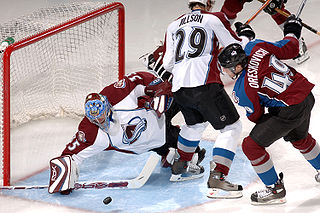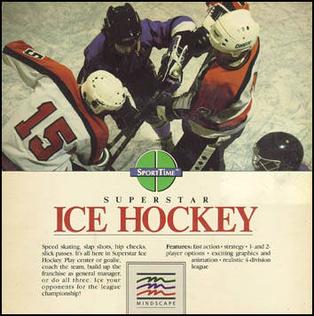
Ice hockey is a team sport played on ice skates, usually on an ice skating rink with lines and markings specific to the sport. It belongs to a family of sports called hockey. In ice hockey, two opposing teams use ice hockey sticks to control, advance, and shoot a closed, vulcanized, rubber disc called a "puck" into the other team's goal. Each goal is worth one point. The team which scores the most goals is declared the winner. In a formal game, each team has six skaters on the ice at a time, barring any penalties, one of whom is the goaltender. Ice hockey is a full contact sport, and is considered to be one of the more physically demanding team sports. It is distinct from field hockey, in which players move a ball around a non-frozen pitch using field hockey sticks.

In many team sports that involve scoring goals, the goalkeeper is a designated player charged with directly preventing the opposing team from scoring by blocking or intercepting opposing shots on goal. Such positions exist in bandy, rink bandy, camogie, association football, Gaelic football, international rules football, floorball, handball, hurling, field hockey, ice hockey, roller hockey, lacrosse, ringette, rinkball, water polo, and shinty, as well as in other sports.
Short-handed is a term used in ice hockey and several related sports, including water polo, and refers to having fewer players on the ice during play, as a result of a penalty. The player removed from play serves the penalty in the penalty box for a set amount of time proportional to the severity of the infraction. If a goaltender commits a minor infraction, another player who was on the ice at the time of the penalty serves, often but not necessarily the team captain.

In ice hockey, the goaltender is the player responsible for preventing the hockey puck from entering their team's net, thus preventing the opposing team from scoring. The goaltender mostly plays in or near the area in front of the net called the goal crease. Goaltenders tend to stay at or beyond the top of the crease to cut down on the angle of shots. In the modern age of goaltending there are two common styles, butterfly and hybrid. Because of the power of shots, the goaltender wears special equipment to protect the body from direct impact.

A penalty in ice hockey is a punishment for an infringement of the rules. Most penalties are enforced by sending the offending player to a penalty box for a set number of minutes. During the penalty the player may not participate in play. Penalties are called and enforced by the referee, or in some cases, the linesman. The offending team may not replace the player on the ice, leaving them short-handed as opposed to full strength. When the opposing team is said to be on a power play, they will have one more player on the ice than the short-handed team. The short-handed team is said to be "on the penalty kill" until the penalty expires and the penalized player returns to play. While standards vary somewhat between leagues, most leagues recognize several common varieties of penalties, as well as common infractions.
In ice hockey, a penalty shot is a type of penalty awarded when a team loses a clear scoring opportunity on a breakaway because of a foul committed by an opposing player. A player from the non-offending team is given an attempt to score a goal without opposition from any defending players except the goaltender. This is the same type of shot used in a shootout to decide games in some leagues.

Fighting is an established tradition in North American ice hockey, with a long history that involves many levels of amateur and professional play and includes some notable individual fights. Fights may be fought by enforcers, or "goons" —players whose role is to fight and intimidate—on a given team, and are governed by a system of unwritten rules that players, coaches, officials, and the media refer to as "the code". Some fights are spontaneous, while others are premeditated by the participants. While officials tolerate fighting during hockey games, they impose a variety of penalties on players who engage in fights.
Violence in sports usually refers to violent and often unnecessarily harmful intentional physical acts committed during, or motivated by, a sports game, often in relation to contact sports such as American football, ice hockey, rugby football, lacrosse, association football, boxing, mixed martial arts, wrestling, and water polo and, when referring to the players themselves, often involving excessively violent or potentially illegal physical contact beyond the normal levels of contact expected while playing the sport. These acts of violence can include intentional attempts to injure a player or coach by another player or coach, but can also include threats of physical harm or actual physical harm sustained by players or coaches by fans or those engaging in the spectating of sports, or threats and acts of violence performed by fans or spectators upon opposing fans or other spectators.
An extra attacker in ice hockey and ringette is a forward or, less commonly, a defenceman who has been substituted in place of the goaltender. The purpose of this substitution is to gain an offensive advantage to score a goal. The removal of the goaltender for an extra attacker is colloquially called pulling the goalie, resulting in an empty net. This article deals chiefly with situations which apply to the sport of ice hockey.

Mutant League Football is a video game that was originally released in 1993 for the Sega Genesis. The game was designed using the John Madden Football '93 engine, and features a different take on American football, where the games resemble a war as much as a sporting competition.

Blades of Steel, later released in Japan as Konamic Ice Hockey, is an ice hockey video game released by Konami for North American arcades in 1987, and ported to the Family Computer Disk System and Nintendo Entertainment System in 1988. All teams are fictional but based out of real Canadian and American cities. The game is known for its fast-paced hockey action and especially for the fighting. It is a one or two player game. When playing against the computer, there are three difficulty levels to choose from: Junior, College, and Pro. Each team consists of three forwards, two defencemen, and a goaltender.

Roller in-line hockey, American roller hockey or inline hockey, is a variant of hockey played on a hard, smooth surface, with players using inline skates to move and ice hockey sticks to shoot a hard, plastic puck into their opponent's goal to score points. The sport is a very fast-paced and free-flowing game and is considered a contact sport, but body checking is prohibited. There are five players including the goalkeeper from each team on the rink at a time, while teams normally consist of 16 players. There are professional leagues, one of which is the National Roller Hockey League (NRHL). While it is not a contact sport, there are exceptions, i.e. the NRHL involves fighting.

The National Hockey League rules are the rules governing the play of the National Hockey League (NHL), a professional ice hockey organization. Infractions of the rules, such as offside and icing, lead to a stoppage of play and subsequent face-offs, while more serious infractions lead to penalties being assessed to the offending team. The league also determines the specifications for playing equipment used in its games.
This is a list of common terms used in the sport of ice hockey along with the definitions of these terms.
Delay of game is a penalty in ice hockey. It results in the offending player spending two minutes in the penalty box. In the NHL, delay of game is usually called under nine circumstances:
- A player or goaltender intentionally shoots or throws the puck out of the playing area.
- A defensive player in the defensive zone shoots the puck directly over the glass. This penalty only applies if the player shoots it over the glass. If the puck is shot into the bench, no penalty is assessed.
- A player or goaltender intentionally knocks the net's goalpost off its moorings, which stops the play. If the net is intentionally knocked loose during a breakaway, the breakaway player is awarded a penalty shot. If there is not enough time in the game to serve the full delay of game penalty, the last player to take a shot is also awarded a penalty shot.
- The player or goalie intentionally keeps the puck behind the net for more than a minute
- The goaltender freezes the puck rather than passing it on to a teammate when no player on the opposing team is within sufficient distance to apply offensive pressure to him.
- Any skater other than the goaltender uses their hands to make the puck unplayable.
- Fans begin to throw objects onto the ice or disrupt the game.
- Beginning from the 2017–18 NHL season, an unsuccessful coach's challenge for offside results in the challenging team being assessed a bench minor for delay of game.
- For adjustments to clothing, equipment, skates or sticks..

Superstar Ice Hockey is a hockey sport game published by Mindscape in 1987.

William John Smith is a Canadian former professional ice hockey goaltender. He won four Stanley Cups with the New York Islanders and was the first goalie to be credited with a goal in the NHL. In 2017 Smith was named one of the 100 Greatest NHL Players in history.
The Hockey Canada Officiating Program is the governing body for on-ice officials for all ice hockey games played under the jurisdiction of Hockey Canada. The Hockey Canada Rulebook provides in-depth explanation and examples of all rules governing hockey in Canada.
The Penguins–Islanders brawl was an incident during a National Hockey League (NHL) regular season ice hockey game between the Pittsburgh Penguins and the New York Islanders that resulted in a record for combined penalty minutes for both teams. The game was played on February 11, 2011, at Nassau Veterans Memorial Coliseum, the home arena of the Islanders at the time. New York won the game 9–3. In all, 65 penalties were assessed, including 15 fighting majors and 21 game misconducts, resulting in a total of 346 penalty minutes.
In ice hockey, an awarded goal is an unusual situation in which a goal is awarded to a team rather than scored. A penalty shot is a type of penalty awarded when a team loses a clear scoring opportunity on a breakaway because of a foul committed by an opposing player. A player from the non-offending team is given an attempt to score a goal without opposition from any defending players except the goaltender. However, when such a lost opportunity occurs and the opposing team has pulled its goalie to allow for an extra attacker, a goal is simply awarded without a penalty shot taking place.











